Race Strategy: World Solar Challenge, Weather Data Analysis
VerifiedAdded on 2023/04/25
|9
|1233
|92
Project
AI Summary
This project focuses on defining a race strategy for solar cars, particularly for the World Solar Challenge. The analysis involves understanding the impact of weather conditions, road profiles, and vehicle performance on the race. The project utilizes historical weather data from the past five years, including factors like sun position, intensity, wind speed, temperature, and road conditions, to create a computational car model. This model integrates solar panel, battery, and motion equations to simulate vehicle performance. The optimization process aims to determine the best velocity pattern for the solar car during the race, considering factors such as energy consumption, wind velocity, and road profile. The project also explores the importance of real-time decision-making and how even minor changes in environmental conditions, like temperature fluctuations, can significantly affect race strategy. The conclusion emphasizes the significance of weather data in designing the drive train, solar panels, and overall vehicle strategy.

PREPARED BY:
DEFINING RACE STRATEGY FOR
WORLD SOLAR CHALLENGE
DEFINING RACE STRATEGY FOR
WORLD SOLAR CHALLENGE
Paraphrase This Document
Need a fresh take? Get an instant paraphrase of this document with our AI Paraphraser
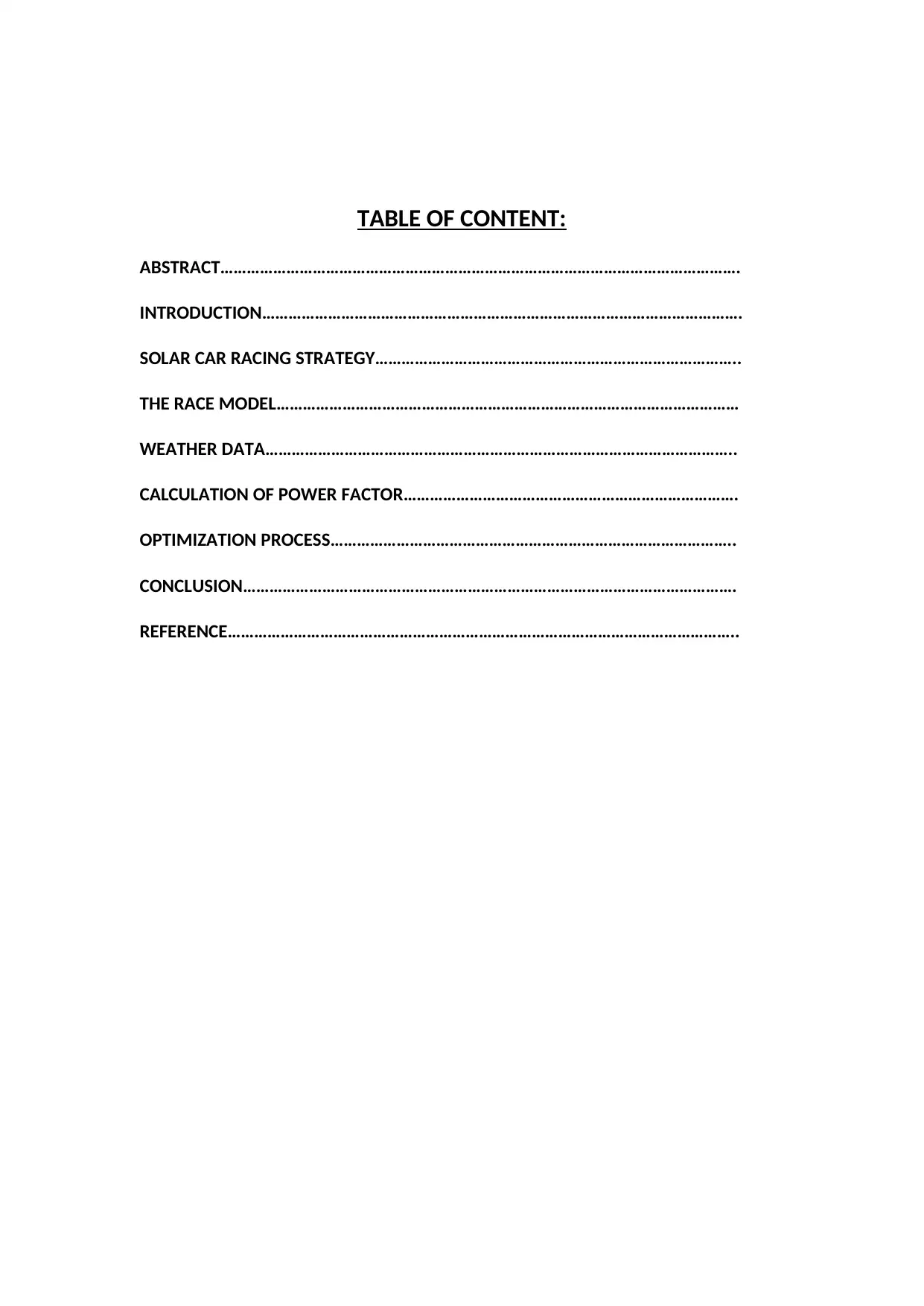
TABLE OF CONTENT:
ABSTRACT……………………………………………………………………………………………………….
INTRODUCTION……………………………………………………………………………………………….
SOLAR CAR RACING STRATEGY………………………………………………………………………..
THE RACE MODEL……………………………………………………………………………………………
WEATHER DATA……………………………………………………………………………………………..
CALCULATION OF POWER FACTOR………………………………………………………………….
OPTIMIZATION PROCESS………………………………………………………………………………..
CONCLUSION………………………………………………………………………………………………….
REFERENCE……………………………………………………………………………………………………..
ABSTRACT……………………………………………………………………………………………………….
INTRODUCTION……………………………………………………………………………………………….
SOLAR CAR RACING STRATEGY………………………………………………………………………..
THE RACE MODEL……………………………………………………………………………………………
WEATHER DATA……………………………………………………………………………………………..
CALCULATION OF POWER FACTOR………………………………………………………………….
OPTIMIZATION PROCESS………………………………………………………………………………..
CONCLUSION………………………………………………………………………………………………….
REFERENCE……………………………………………………………………………………………………..
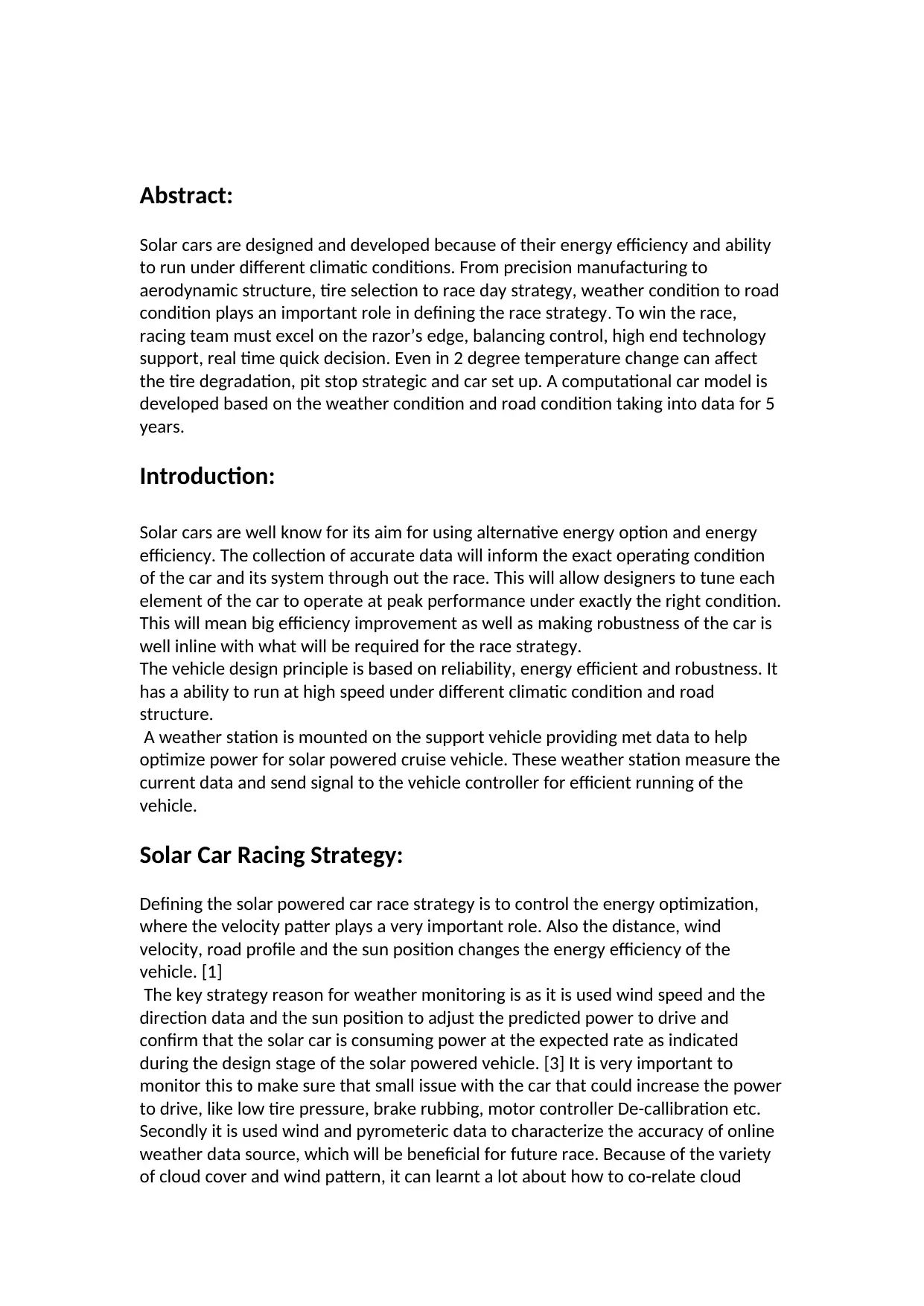
Abstract:
Solar cars are designed and developed because of their energy efficiency and ability
to run under different climatic conditions. From precision manufacturing to
aerodynamic structure, tire selection to race day strategy, weather condition to road
condition plays an important role in defining the race strategy. To win the race,
racing team must excel on the razor’s edge, balancing control, high end technology
support, real time quick decision. Even in 2 degree temperature change can affect
the tire degradation, pit stop strategic and car set up. A computational car model is
developed based on the weather condition and road condition taking into data for 5
years.
Introduction:
Solar cars are well know for its aim for using alternative energy option and energy
efficiency. The collection of accurate data will inform the exact operating condition
of the car and its system through out the race. This will allow designers to tune each
element of the car to operate at peak performance under exactly the right condition.
This will mean big efficiency improvement as well as making robustness of the car is
well inline with what will be required for the race strategy.
The vehicle design principle is based on reliability, energy efficient and robustness. It
has a ability to run at high speed under different climatic condition and road
structure.
A weather station is mounted on the support vehicle providing met data to help
optimize power for solar powered cruise vehicle. These weather station measure the
current data and send signal to the vehicle controller for efficient running of the
vehicle.
Solar Car Racing Strategy:
Defining the solar powered car race strategy is to control the energy optimization,
where the velocity patter plays a very important role. Also the distance, wind
velocity, road profile and the sun position changes the energy efficiency of the
vehicle. [1]
The key strategy reason for weather monitoring is as it is used wind speed and the
direction data and the sun position to adjust the predicted power to drive and
confirm that the solar car is consuming power at the expected rate as indicated
during the design stage of the solar powered vehicle. [3] It is very important to
monitor this to make sure that small issue with the car that could increase the power
to drive, like low tire pressure, brake rubbing, motor controller De-callibration etc.
Secondly it is used wind and pyrometeric data to characterize the accuracy of online
weather data source, which will be beneficial for future race. Because of the variety
of cloud cover and wind pattern, it can learnt a lot about how to co-relate cloud
Solar cars are designed and developed because of their energy efficiency and ability
to run under different climatic conditions. From precision manufacturing to
aerodynamic structure, tire selection to race day strategy, weather condition to road
condition plays an important role in defining the race strategy. To win the race,
racing team must excel on the razor’s edge, balancing control, high end technology
support, real time quick decision. Even in 2 degree temperature change can affect
the tire degradation, pit stop strategic and car set up. A computational car model is
developed based on the weather condition and road condition taking into data for 5
years.
Introduction:
Solar cars are well know for its aim for using alternative energy option and energy
efficiency. The collection of accurate data will inform the exact operating condition
of the car and its system through out the race. This will allow designers to tune each
element of the car to operate at peak performance under exactly the right condition.
This will mean big efficiency improvement as well as making robustness of the car is
well inline with what will be required for the race strategy.
The vehicle design principle is based on reliability, energy efficient and robustness. It
has a ability to run at high speed under different climatic condition and road
structure.
A weather station is mounted on the support vehicle providing met data to help
optimize power for solar powered cruise vehicle. These weather station measure the
current data and send signal to the vehicle controller for efficient running of the
vehicle.
Solar Car Racing Strategy:
Defining the solar powered car race strategy is to control the energy optimization,
where the velocity patter plays a very important role. Also the distance, wind
velocity, road profile and the sun position changes the energy efficiency of the
vehicle. [1]
The key strategy reason for weather monitoring is as it is used wind speed and the
direction data and the sun position to adjust the predicted power to drive and
confirm that the solar car is consuming power at the expected rate as indicated
during the design stage of the solar powered vehicle. [3] It is very important to
monitor this to make sure that small issue with the car that could increase the power
to drive, like low tire pressure, brake rubbing, motor controller De-callibration etc.
Secondly it is used wind and pyrometeric data to characterize the accuracy of online
weather data source, which will be beneficial for future race. Because of the variety
of cloud cover and wind pattern, it can learnt a lot about how to co-relate cloud
⊘ This is a preview!⊘
Do you want full access?
Subscribe today to unlock all pages.

Trusted by 1+ million students worldwide
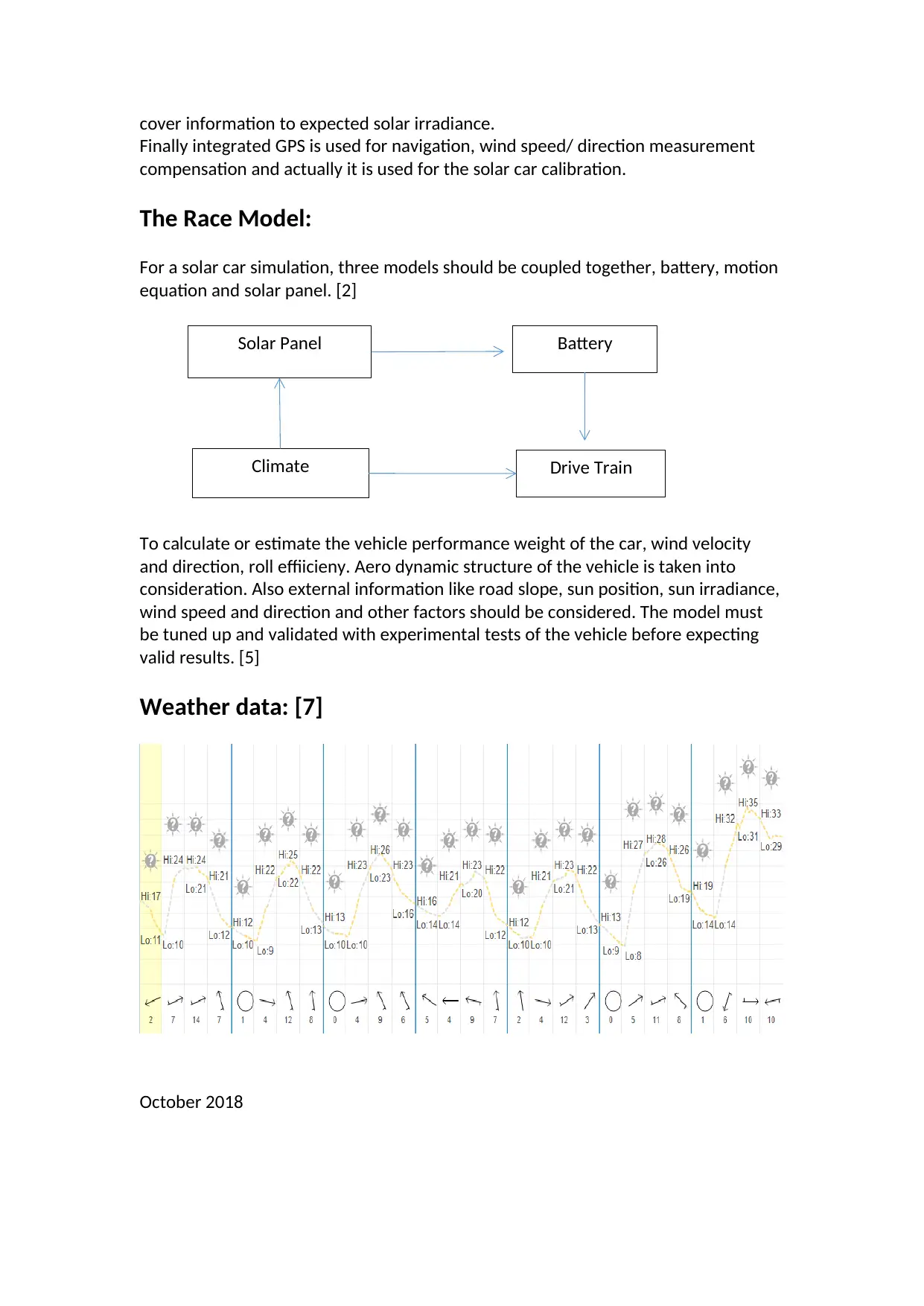
cover information to expected solar irradiance.
Finally integrated GPS is used for navigation, wind speed/ direction measurement
compensation and actually it is used for the solar car calibration.
The Race Model:
For a solar car simulation, three models should be coupled together, battery, motion
equation and solar panel. [2]
To calculate or estimate the vehicle performance weight of the car, wind velocity
and direction, roll effiicieny. Aero dynamic structure of the vehicle is taken into
consideration. Also external information like road slope, sun position, sun irradiance,
wind speed and direction and other factors should be considered. The model must
be tuned up and validated with experimental tests of the vehicle before expecting
valid results. [5]
Weather data: [7]
October 2018
Solar Panel Battery
Climate Drive Train
Finally integrated GPS is used for navigation, wind speed/ direction measurement
compensation and actually it is used for the solar car calibration.
The Race Model:
For a solar car simulation, three models should be coupled together, battery, motion
equation and solar panel. [2]
To calculate or estimate the vehicle performance weight of the car, wind velocity
and direction, roll effiicieny. Aero dynamic structure of the vehicle is taken into
consideration. Also external information like road slope, sun position, sun irradiance,
wind speed and direction and other factors should be considered. The model must
be tuned up and validated with experimental tests of the vehicle before expecting
valid results. [5]
Weather data: [7]
October 2018
Solar Panel Battery
Climate Drive Train
Paraphrase This Document
Need a fresh take? Get an instant paraphrase of this document with our AI Paraphraser
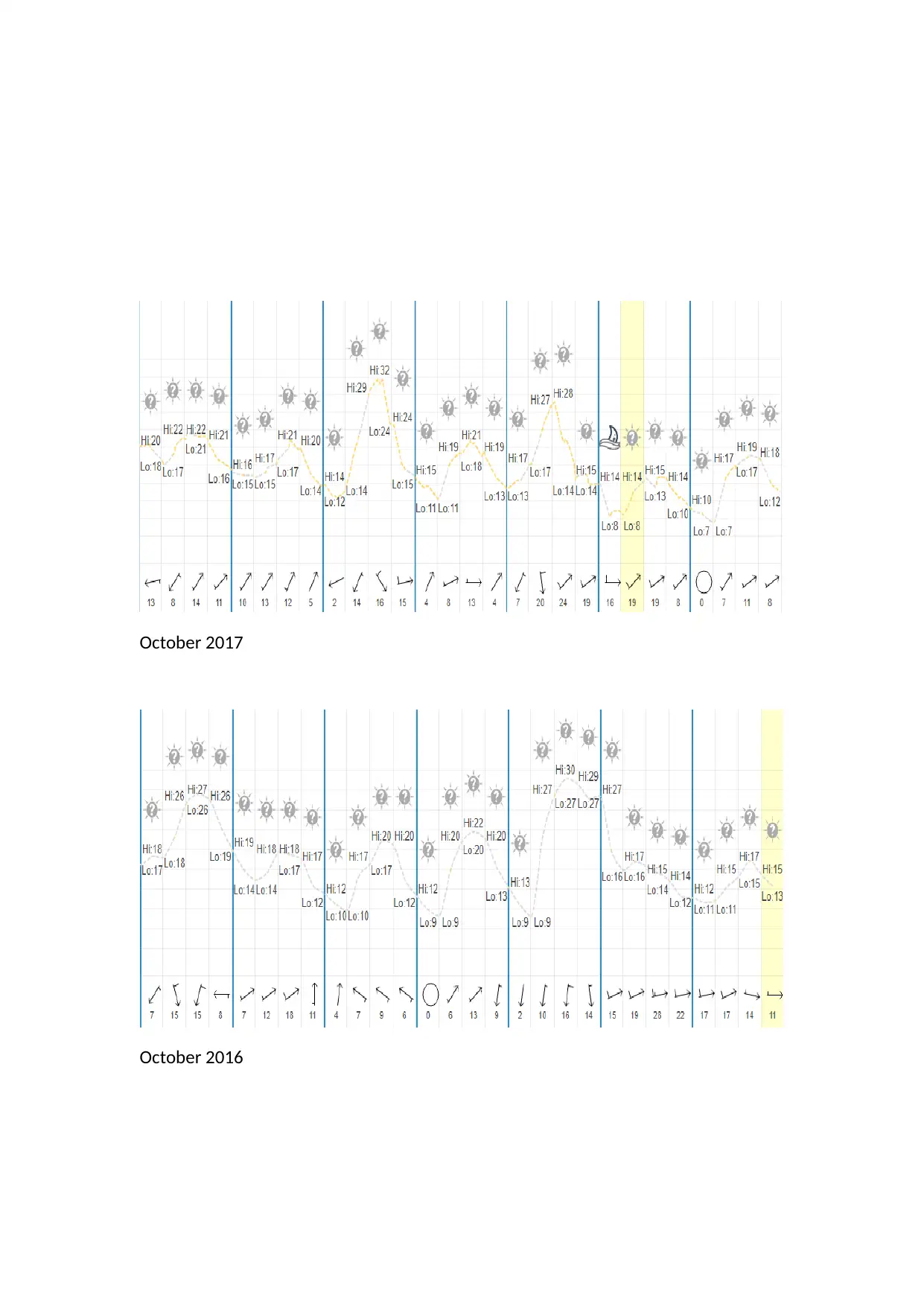
October 2017
October 2016
October 2016
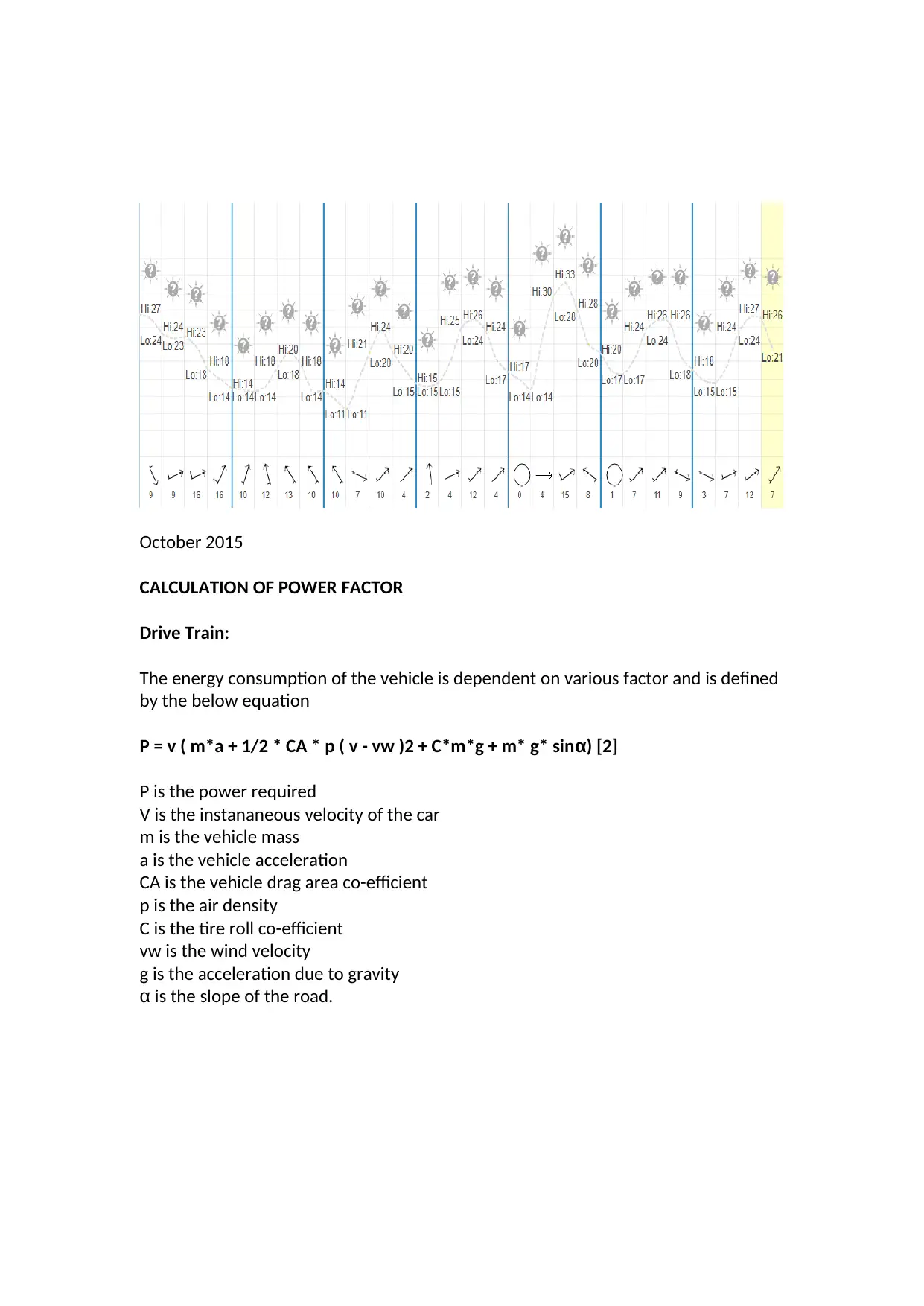
October 2015
CALCULATION OF POWER FACTOR
Drive Train:
The energy consumption of the vehicle is dependent on various factor and is defined
by the below equation
P = v ( m*a + 1/2 * CA * p ( v - vw )2 + C*m*g + m* g* sinα) [2]
P is the power required
V is the instananeous velocity of the car
m is the vehicle mass
a is the vehicle acceleration
CA is the vehicle drag area co-efficient
p is the air density
C is the tire roll co-efficient
vw is the wind velocity
g is the acceleration due to gravity
α is the slope of the road.
CALCULATION OF POWER FACTOR
Drive Train:
The energy consumption of the vehicle is dependent on various factor and is defined
by the below equation
P = v ( m*a + 1/2 * CA * p ( v - vw )2 + C*m*g + m* g* sinα) [2]
P is the power required
V is the instananeous velocity of the car
m is the vehicle mass
a is the vehicle acceleration
CA is the vehicle drag area co-efficient
p is the air density
C is the tire roll co-efficient
vw is the wind velocity
g is the acceleration due to gravity
α is the slope of the road.
⊘ This is a preview!⊘
Do you want full access?
Subscribe today to unlock all pages.

Trusted by 1+ million students worldwide
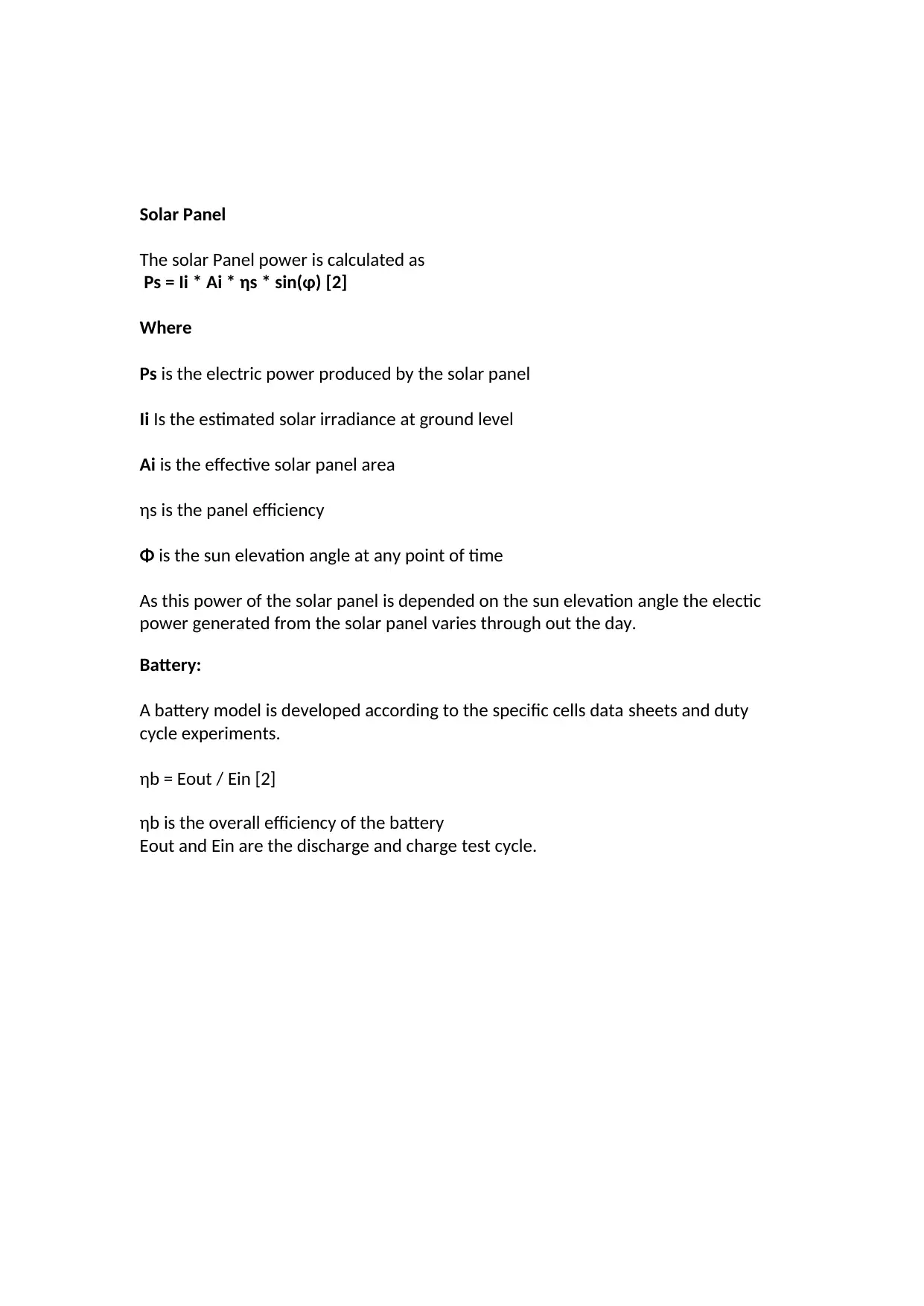
Solar Panel
The solar Panel power is calculated as
Ps = Ii * Ai * ηs * sin(φ) [2]
Where
Ps is the electric power produced by the solar panel
Ii Is the estimated solar irradiance at ground level
Ai is the effective solar panel area
ηs is the panel efficiency
Φ is the sun elevation angle at any point of time
As this power of the solar panel is depended on the sun elevation angle the electic
power generated from the solar panel varies through out the day.
Battery:
A battery model is developed according to the specific cells data sheets and duty
cycle experiments.
ηb = Eout / Ein [2]
ηb is the overall efficiency of the battery
Eout and Ein are the discharge and charge test cycle.
The solar Panel power is calculated as
Ps = Ii * Ai * ηs * sin(φ) [2]
Where
Ps is the electric power produced by the solar panel
Ii Is the estimated solar irradiance at ground level
Ai is the effective solar panel area
ηs is the panel efficiency
Φ is the sun elevation angle at any point of time
As this power of the solar panel is depended on the sun elevation angle the electic
power generated from the solar panel varies through out the day.
Battery:
A battery model is developed according to the specific cells data sheets and duty
cycle experiments.
ηb = Eout / Ein [2]
ηb is the overall efficiency of the battery
Eout and Ein are the discharge and charge test cycle.
Paraphrase This Document
Need a fresh take? Get an instant paraphrase of this document with our AI Paraphraser
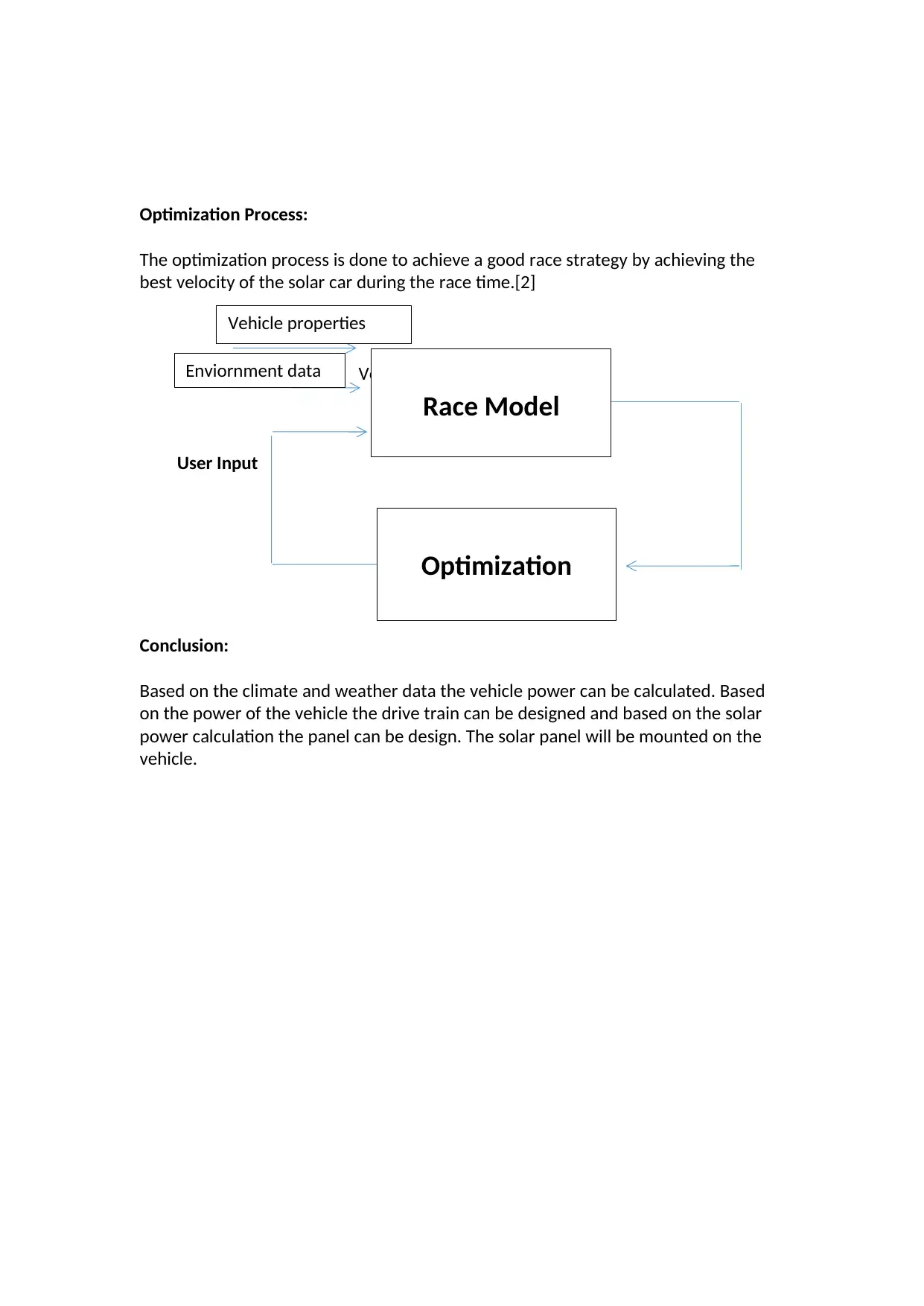
Optimization Process:
The optimization process is done to achieve a good race strategy by achieving the
best velocity of the solar car during the race time.[2]
Vehicle Performance
User Input
Conclusion:
Based on the climate and weather data the vehicle power can be calculated. Based
on the power of the vehicle the drive train can be designed and based on the solar
power calculation the panel can be design. The solar panel will be mounted on the
vehicle.
Race Model
Optimization
Vehicle properties
Enviornment data
The optimization process is done to achieve a good race strategy by achieving the
best velocity of the solar car during the race time.[2]
Vehicle Performance
User Input
Conclusion:
Based on the climate and weather data the vehicle power can be calculated. Based
on the power of the vehicle the drive train can be designed and based on the solar
power calculation the panel can be design. The solar panel will be mounted on the
vehicle.
Race Model
Optimization
Vehicle properties
Enviornment data
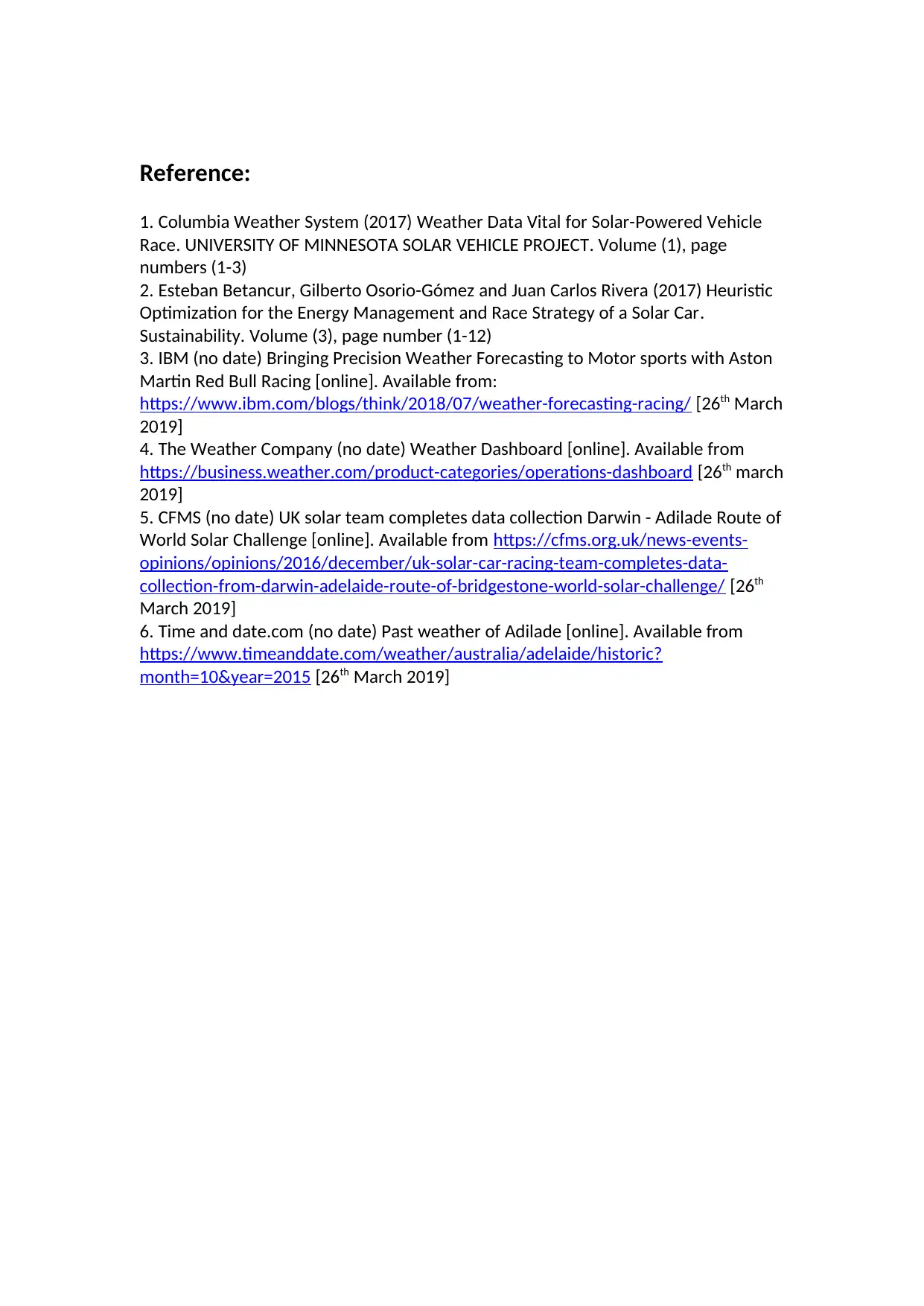
Reference:
1. Columbia Weather System (2017) Weather Data Vital for Solar-Powered Vehicle
Race. UNIVERSITY OF MINNESOTA SOLAR VEHICLE PROJECT. Volume (1), page
numbers (1-3)
2. Esteban Betancur, Gilberto Osorio-Gómez and Juan Carlos Rivera (2017) Heuristic
Optimization for the Energy Management and Race Strategy of a Solar Car.
Sustainability. Volume (3), page number (1-12)
3. IBM (no date) Bringing Precision Weather Forecasting to Motor sports with Aston
Martin Red Bull Racing [online]. Available from:
https://www.ibm.com/blogs/think/2018/07/weather-forecasting-racing/ [26th March
2019]
4. The Weather Company (no date) Weather Dashboard [online]. Available from
https://business.weather.com/product-categories/operations-dashboard [26th march
2019]
5. CFMS (no date) UK solar team completes data collection Darwin - Adilade Route of
World Solar Challenge [online]. Available from https://cfms.org.uk/news-events-
opinions/opinions/2016/december/uk-solar-car-racing-team-completes-data-
collection-from-darwin-adelaide-route-of-bridgestone-world-solar-challenge/ [26th
March 2019]
6. Time and date.com (no date) Past weather of Adilade [online]. Available from
https://www.timeanddate.com/weather/australia/adelaide/historic?
month=10&year=2015 [26th March 2019]
1. Columbia Weather System (2017) Weather Data Vital for Solar-Powered Vehicle
Race. UNIVERSITY OF MINNESOTA SOLAR VEHICLE PROJECT. Volume (1), page
numbers (1-3)
2. Esteban Betancur, Gilberto Osorio-Gómez and Juan Carlos Rivera (2017) Heuristic
Optimization for the Energy Management and Race Strategy of a Solar Car.
Sustainability. Volume (3), page number (1-12)
3. IBM (no date) Bringing Precision Weather Forecasting to Motor sports with Aston
Martin Red Bull Racing [online]. Available from:
https://www.ibm.com/blogs/think/2018/07/weather-forecasting-racing/ [26th March
2019]
4. The Weather Company (no date) Weather Dashboard [online]. Available from
https://business.weather.com/product-categories/operations-dashboard [26th march
2019]
5. CFMS (no date) UK solar team completes data collection Darwin - Adilade Route of
World Solar Challenge [online]. Available from https://cfms.org.uk/news-events-
opinions/opinions/2016/december/uk-solar-car-racing-team-completes-data-
collection-from-darwin-adelaide-route-of-bridgestone-world-solar-challenge/ [26th
March 2019]
6. Time and date.com (no date) Past weather of Adilade [online]. Available from
https://www.timeanddate.com/weather/australia/adelaide/historic?
month=10&year=2015 [26th March 2019]
⊘ This is a preview!⊘
Do you want full access?
Subscribe today to unlock all pages.

Trusted by 1+ million students worldwide
1 out of 9
Related Documents
Your All-in-One AI-Powered Toolkit for Academic Success.
+13062052269
info@desklib.com
Available 24*7 on WhatsApp / Email
![[object Object]](/_next/static/media/star-bottom.7253800d.svg)
Unlock your academic potential
Copyright © 2020–2025 A2Z Services. All Rights Reserved. Developed and managed by ZUCOL.




